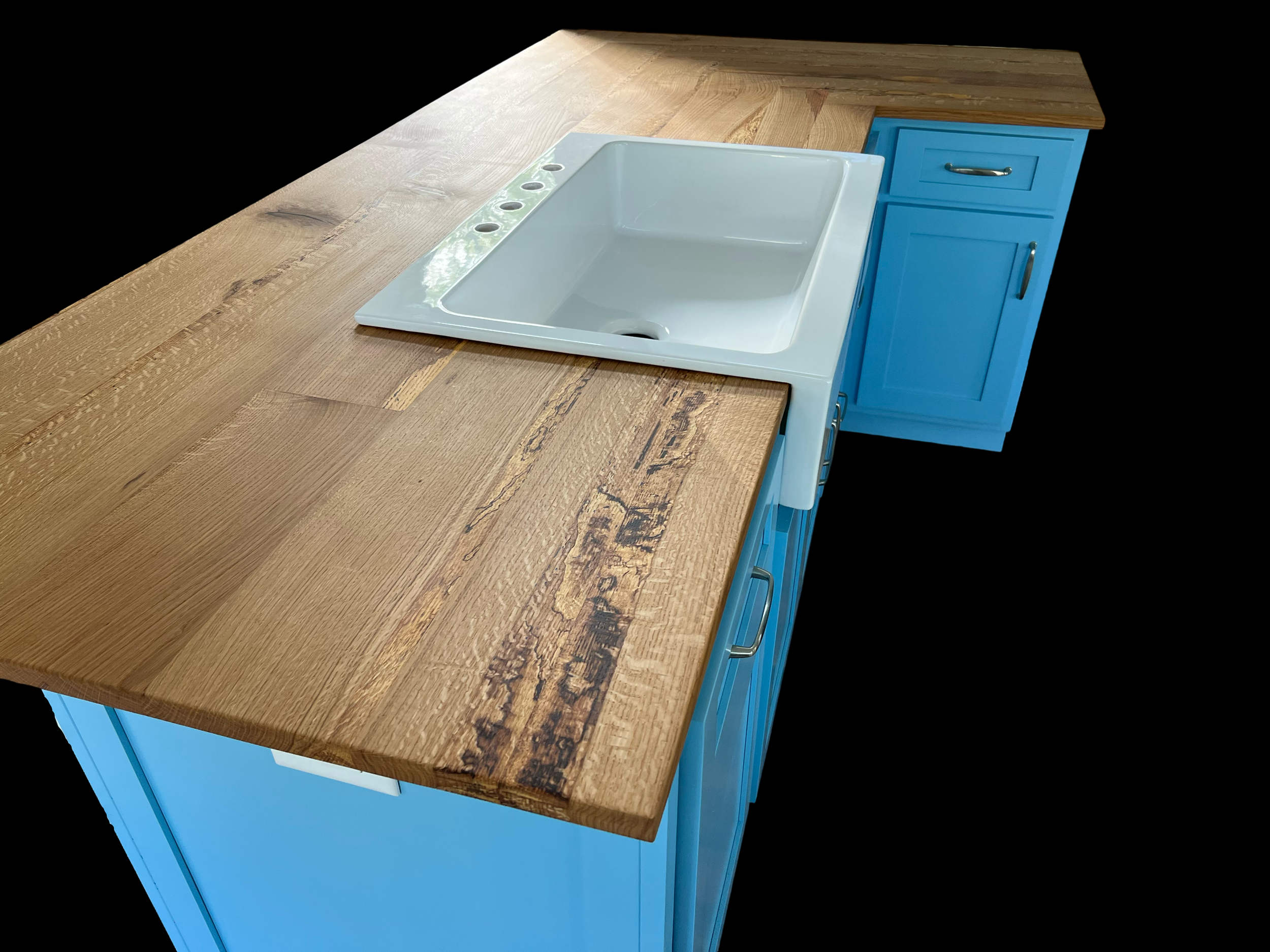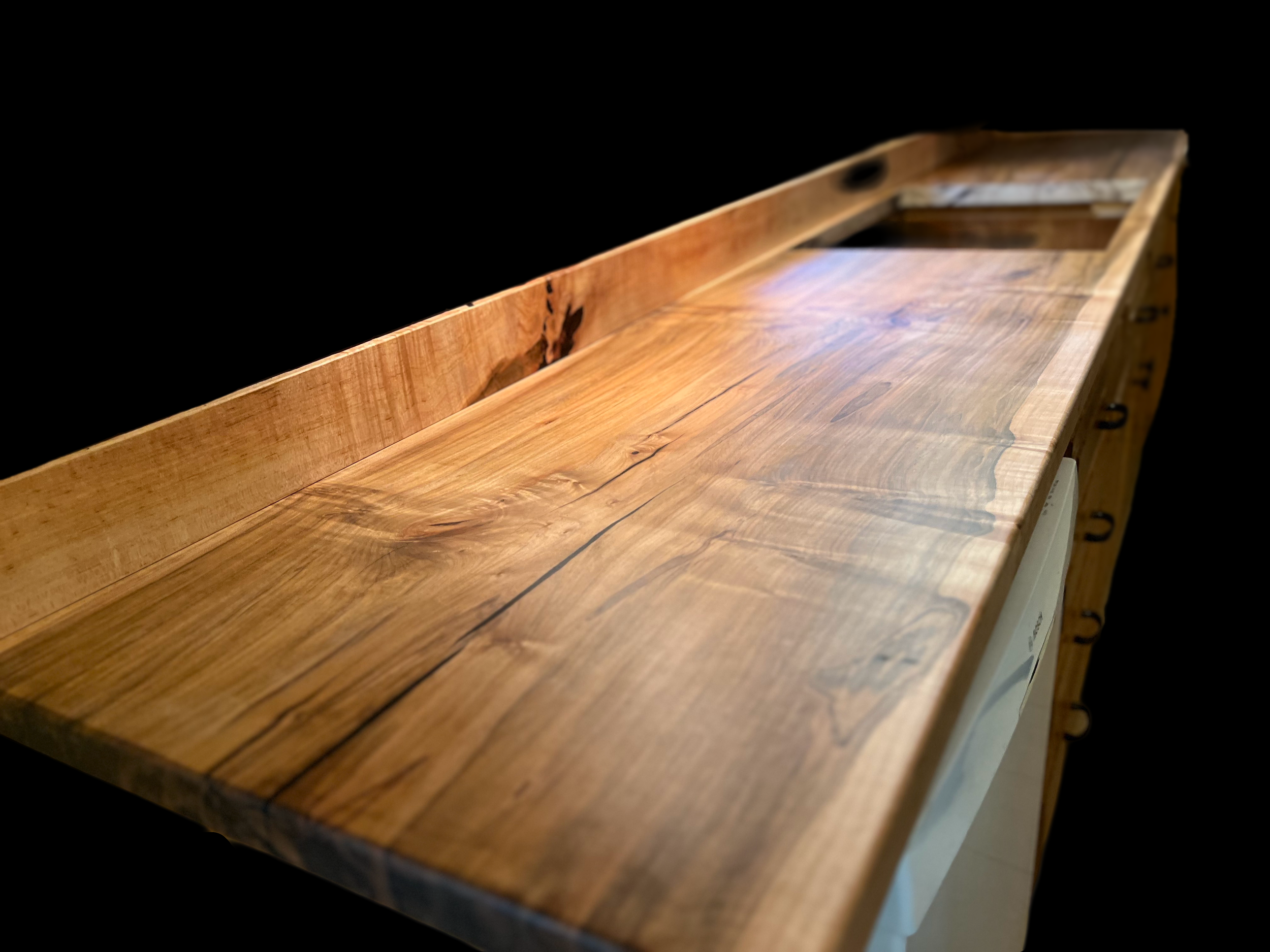Explaining Various Types of Kitchen Countertops - Plastic Laminate, Solid Surfacing, Wood and Stainless Steel Countertops
It's fair to say that the countertop is like the carpenter's workbench. It's where we lay out supplies, peel and chop, roll and knead, mix and serve. It needs to be tough, level, smooth, and large enough for the work we do. It's not enough to be big, tough, and versatile, however; countertops have to look good, too. But the choices are dizzying, not only for countertop material but also for finish and edge treatments, connections to sinks, and connections to backsplashes. Today, a good answer is a multiple choice, and selecting different countertop materials to suit different tasks is frequently the answer.
Choosing a countertop is best done when choosing a sink so the two function, visually and practically, in concert with one another. It may not be a showstopper like a range, but a sink is a hardest-working item in a kitchen, so you won't regret spending a little more for a sturdy, big-enough, good-looking sink-or two. It's not surprising that two-thirds of new kitchens have a second sink, it's a great way to preserve kitchen harmony.
Countertops and Backsplashes
Sufficient, comfortable counter space is crucial in the kitchen. The accompanying backsplash serves many purposes, from visual interest, to wall protection, to easing cleanup. The materials chosen for both should be carefully considered on all fronts, from budget to durability, to looks.
Ideal Length and Height of Countertops
A kitchen needs at least one 36-in. continuous countertop, preferably sink-side. For two cooks, double that, but keep the workspaces separate if possible. Refrigerators and cooktops need landing spaces (15 in. or more if possible) on one or two sides.
Countertop height should be dictated by preference and the purpose the surface will serve. While the standard is 36 in., a countertop used for cutting should be from 4 in. to 6 in. below your bent elbow Kneading bread and rolling pastry is easier on lower surfaces, while dining countertops can range from table height (29 in. to 30 in.) to 42 in.
Backsplash heights should be varied to suit the needs of a particular area. This granite backsplash stops just under the windowsill, which is a little higher than usual to avoid water damage. For the rest of the backsplash area, the wall is finished with bead board, a hardier surface than painted gypsum board.
Countertop heights in this kitchen vary to suit the task, with a 42-in. high countertop anchoring the end of an L-shaped configuration of maple cabinets. The cantilevered stone counter with eased edges gets necessary support from wood brackets.
Plastic Laminate
Plastic laminate may not be the latest rage, but it's still used in most kitchens for the same reasons that it surged to prominence in the mid-20th century. It is easy to install, easy to clean, has good stain resistance, and is economical. The disadvantage? Plastic laminate is not resistant to stains, can't be cut on without damage, can't be repaired, and scorches easily, though high-wear, extra thick, fire-retardant plastic laminate is available for more money. Also, while plastic laminate itself resists water, if water gets into a seam it can damage the substrate, so it's imperative to seal the sink cutout and all other joints.
One aesthetic drawback to the plastic laminate-the dark line of the Kraft-paper core visible along a straight edge can easily be covered by an edge band of wood or metal or by beveling the plastic laminate. If you want a more interesting look, digital printing now allows the laminate to mimic stone, wood, and other materials with great accuracy.
The countertop along the wall in this comfortable kitchen is a plastic laminate with a bull-nosed wood nosing and wood trim at the bottom of the tile backsplash. The island is solid-surface with enough overhang to make standing at the counter easy.
Solid Surfacing
A little over 35 years old, solid-surfacing is made from polyester or acrylic resin in addition to a mineral filler. Its homogenous quality allows minor scratches to be sanded away, and it is non-porous, easy to clean, highly stain resistant, and can be formed with integral sinks and backsplashes. Solid-surfacing edges can take just about any profile, and it can be formed with color accents at edges or anywhere else on the surface.
Solid Surfacing Drawbacks
Drawbacks to solid-surfacing are its high relative cost (it can cost 10 times as much as plastic laminate and as much as some stones) and its vulnerability to heat, don't set a hot pot directly on solid-surfacing, as there's a slight possibility it can melt or crack.
A white solid-surface countertop with eased edges brightens an urban kitchen that has only one window. Flat white 4-in. square tile makes a water and heatproof backsplash. The space is between the cabinets is filled with flat trim topped with crown molding and painted a darker gold to match the softwood floor.
Wood Countertops
Wood of many species can work beautifully as a countertop material if it is properly finished and maintained. In addition to its visual warmth and soft sound, it's easy on dishes and glassware and can be shaped into many profiles and configurations. On the downside, it's susceptible to water damage and scarring and costs around twice as much as plastic laminate. Choosing the proper type of wood countertop and finish will help ensure both aesthetic appeal and longevity. For details on wood selection, visit our blog “Choosing the Right Lumber for Your Indoor and Outdoor Projects”
Butcher Block – Hard Maple Strips
Butcher block is one of the most common types of wood countertops, but the term "butcher block" has more than one meaning. It traditionally refers to end-grain butcher block, which is porous and thus considered unsanitary for restaurant work (but you may feel otherwise, considering some recent studies indicating that wood cutting boards may retain fewer bacteria than plastic). Today, residential butcher block refers to 1½ in. hard-maple strips laminated together with edge grain up. Edge-grain butcher block is less porous than end grain but not as hard, so while you can cut on it, it will splinter more than end grain.
Face-Grain Wood – Cherry, Teak, and Oak
Face-grain wood (wider boards) is too soft for cutting but makes a handsome serving or eating countertop. Many species, such as cherry, teak, or oak, can be used for this type of countertop since you won't be cutting on it. You can pay us a visit at Wild Edge Wood Craft for selecting various types of woods, or simply visit our website for information.
Your happiness with a wood countertop depends both on a love for the patina it will develop and on diligent maintenance. Sand out scratches or consider them part of the character. A wood countertop used for chopping fruits and vegetables (cut meats only on portable, washable cutting boards) can be left unsealed and maintained with periodic rubdowns with mineral, tung, linseed, or other nontoxic oil.
Preventing Wood from Water Damage
Wood's Achilles heel is susceptible to water damage. Rather than air drying wood countertops, dry them thoroughly with dish or paper towels. Wood that won't be used for cutting can be sealed with countertop-friendly polyurethane (undersides, too, to prevent warping), and any wood countertop around a sink requires several coats on all surfaces.
Stainless Steel and Other Metals
The ultimate in resistance to water, staining, and heat is, of course, stainless steel, the countertop of choice in restaurants everywhere. It can be shaped and seamed to provide an integral nosing, as well as an integral backsplash and sink. Stainless steel has a long, long life, and after the first few months, when every fingerprint and scratch shows up, it will develop a patina that hides minor scratches.
The strongest stainless-steel countertops are 16 gauge to 14 gauge (the lower the number, the thicker the steel). Whatever the gauge, a stainless-steel countertop should be set or formed around plywood or medium-density fiberboard (¾ in. is recommended) to add strength and mute the sound.
Other Metals – Copper and Zinc
Other metals making their way into today's kitchens include copper and zinc, although these are softer and more prone to staining, unlike stainless steel. These materials are ideal for a backsplash, which doesn't see the action that a countertop does.




